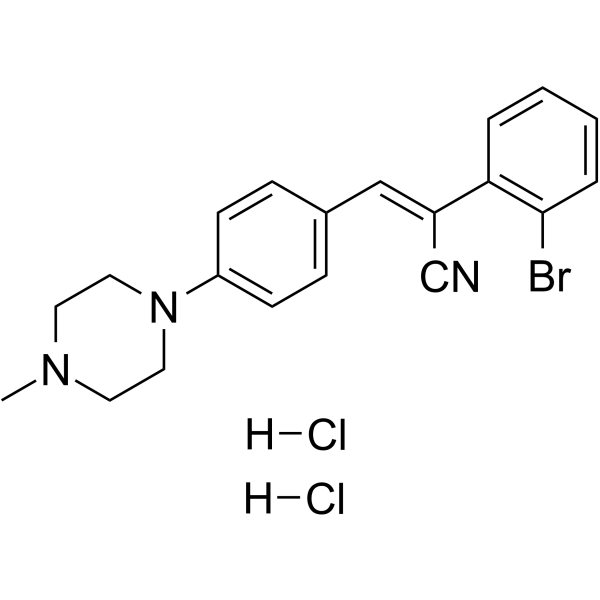上海金畔生物科技有限公司为生命科学和医药研发人员提供生物活性分子抑制剂、激动剂、特异性抑制剂、化合物库、重组蛋白,专注于信号通路和疾病研究领域。
DG172 dihydrochloride 纯度: 99.03%
DG172 dihydrochloride 是一种选择性的 PPARβ/δ 拮抗剂,IC50 值为 27 nM。

DG172 dihydrochloride Chemical Structure
CAS No. : 1361504-77-9
| 规格 | 价格 | 是否有货 | 数量 |
|---|---|---|---|
| Free Sample (0.1-0.5 mg) | Apply now | ||
| 10 mM * 1 mL in Water | ¥1155 | In-stock | |
| 5 mg | ¥1050 | In-stock | |
| 10 mg | ¥1600 | In-stock | |
| 50 mg | ¥6400 | In-stock | |
| 100 mg | ¥11000 | In-stock | |
| 200 mg | 询价 | ||
| 500 mg | 询价 |
* Please select Quantity before adding items.
DG172 dihydrochloride 相关产品
•相关化合物库:
- Covalent Screening Library Plus
- Bioactive Compound Library Plus
- Cell Cycle/DNA Damage Compound Library
- Anti-Cancer Compound Library
- Anti-Aging Compound Library
- Covalent Screening Library
- Transcription Factor Targeted Library
- Targeted Diversity Library
| 生物活性 |
DG172 dihydrochloride is a selective PPARβ/δ antagonist, with an IC50 of 27 nM. |
||||||||||||||||
|---|---|---|---|---|---|---|---|---|---|---|---|---|---|---|---|---|---|
| IC50 & Target[1] |
|
||||||||||||||||
| 体外研究 (In Vitro) |
DG172 dihydrochloride is a selective PPARβ/δ antagonist, with an IC50 of 27 nM. DG172 enhances transcriptional corepressor recruitment, and down-regulates transcription of the PPARβ/δ target gene Angptl4 in mouse myoblasts (IC50, 9.5 nM)[1]. DG172 (1 µM) promotes the differentiation of dendritic cells (DCs) from GM-CSF-induced mouse bone marrow cells (BMCs) and reduces Ly6b+/Gr1+ granulocytic cells. DG172 has effects on the transcriptome of GM-CSF differentiated BMCs from WT and Ppard null mice, and acts at a specific stage of GM-CSF-induced differentiation[2]. DG172 (0.1, 1.0 µM) dose-dependently promotes proliferation of TM4 cells. DG172 reduces expression of claudin-11 in TM4 cells[3]. 上海金畔生物科技有限公司 has not independently confirmed the accuracy of these methods. They are for reference only. |
||||||||||||||||
| 分子量 |
455.22 |
||||||||||||||||
| Formula |
C20H22BrCl2N3 |
||||||||||||||||
| CAS 号 |
1361504-77-9 |
||||||||||||||||
| 运输条件 |
Room temperature in continental US; may vary elsewhere. |
||||||||||||||||
| 储存方式 |
4°C, sealed storage, away from moisture *In solvent : -80°C, 6 months; -20°C, 1 month (sealed storage, away from moisture) |
||||||||||||||||
| 溶解性数据 |
In Vitro:
H2O : 14.29 mg/mL (31.39 mM; Need ultrasonic) 配制储备液
*
请根据产品在不同溶剂中的溶解度选择合适的溶剂配制储备液;一旦配成溶液,请分装保存,避免反复冻融造成的产品失效。 |
||||||||||||||||
| 参考文献 |
|
| Cell Assay [3] |
The xCELLigence system is used for determining the changes in real time cell proliferation in response to activation of PPARD with an agonist (GW0742) or an inverse agonist (DG172) or the effect of inhibiting ERK signaling in TM4 cells[3]. 上海金畔生物科技有限公司 has not independently confirmed the accuracy of these methods. They are for reference only. |
|---|---|
| 参考文献 |
|
所有产品仅用作科学研究或药证申报,我们不为任何个人用途提供产品和服务
